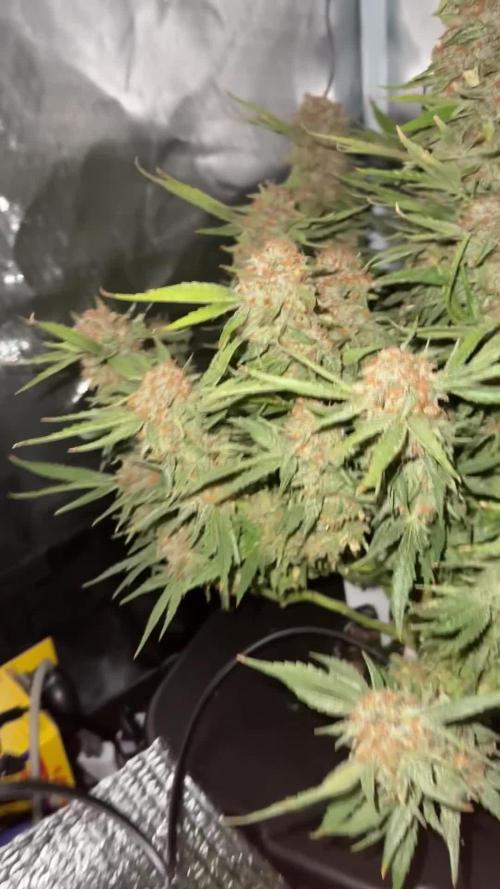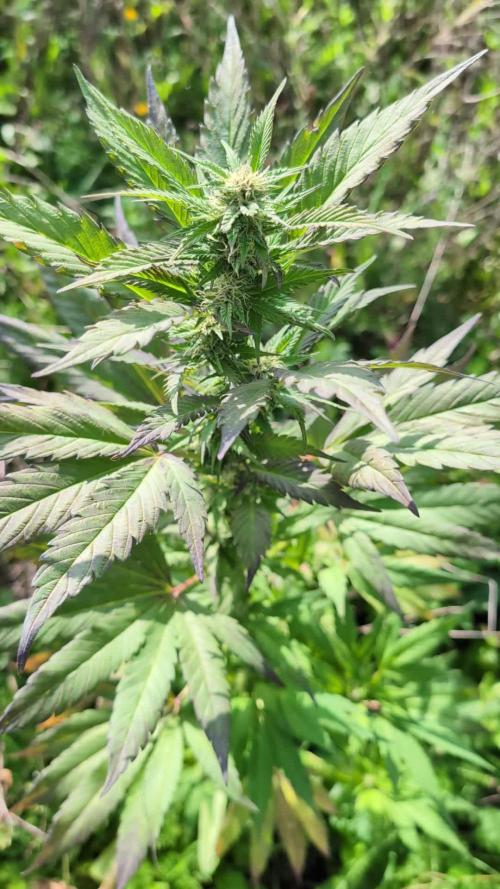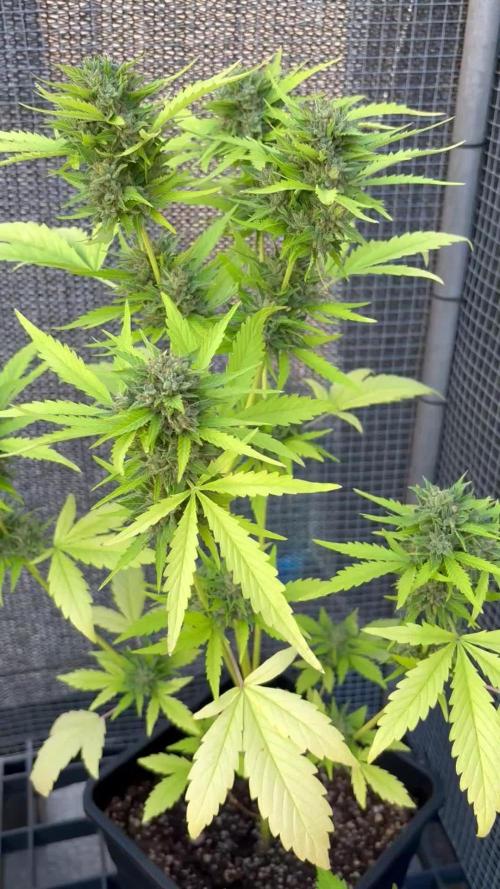The Grow Awards 2026 🏆 

































Processing
Likes
6
Share


@Lennys_Laboratory
Follow
Clocks changed to 12/12 . They're Looking Beautiful ⚡️
Likes
7
Share


@Enki_Weed
Follow
In den letzten ein bis zwei Wochen hat sich unsere Pflanze weiterhin prächtig entwickelt und zeigt nun deutliche Anzeichen einer fortgeschrittenen Blütephase. Es gab keine dramatischen Veränderungen, sondern eine stetige Reifung, die uns dem Erntezeitpunkt näherbringt.
Die Pflanze präsentiert sich sehr buschig und vital, mit zahlreichen dichten Blütenständen, die sich gut ausgebildet haben (siehe Gesamtansicht der Pflanze). Die Buds sind kompakt und haben in den letzten Wochen an Volumen und Gewicht zugelegt. Man kann deutlich sehen, wie die Blütenkelche anschwellen und sich zu reifen Blütenständen formen.
Trichom- und Stigmen-Reife:
Ein genauerer Blick auf die Buds (wie im ersten Nahaufnahme-Bild der Trichome und im weiteren Nahaufnahme-Bild der Buds mit orangenen Stigmen ersichtlich) zeigt den Fortschritt der Reifung. Die weißen, harzigen Trichome bedecken die Blütenstände in Hülle und Fülle, was auf eine intensive Produktion von Cannabinoiden hinweist. Bei den Trichomen ist nun eine gute Mischung aus milchig-trüben Köpfen zu erkennen, die auf die volle Potenz hindeuten. Erste bernsteinfarbene Trichome beginnen ebenfalls aufzutreten, was ein Zeichen dafür ist, dass der Erntezeitpunkt bevorsteht.
Parallel dazu haben sich die Stigmen (die feinen Härchen auf den Buds) von Weiß zu einem satten Orange-Braun verfärbt. Dies ist ein weiteres starkes Indiz für die Reife der Blüten und die nahende Ernte.
Blattwerk und Nährstoffbedarf:
Das Blattwerk der Pflanze ist größtenteils weiterhin gesund und grün, was auf eine gute Nährstoffversorgung schließen lässt. Einige der größeren Fächerblätter können in dieser späten Blütephase leichte Anzeichen von Vergilbung zeigen, da die Pflanze ihre Energie nun primär in die Blütenentwicklung steckt und Nährstoffe aus den Blättern zieht. Dies ist ein natürlicher Prozess, der oft als "Herbstfärbung" bezeichnet wird.
Wir werden die Reifung der Trichome weiterhin genauestens beobachten, um den optimalen Erntezeitpunkt zu bestimmen, der je nach gewünschtem Effekt variieren kann. Auch die allgemeine Gesundheit der Pflanze wird weiterhin im Auge behalten, um sicherzustellen, dass sie bis zur Ernte optimal versorgt ist.
Likes
5
Share


@JardineiroBr
Follow
Chegando ao fim mais um ciclo , gostei das sementes e o resultado final ainda que não seja muito em quantidade pode ser favorável em qualidade .
Processing
Likes
1
Share


@MG2009
Follow
09/10/2019
She is repotted. I put 0-5-0 an inch below plant off to each side it should reach it in a couple weeks helping development of the roots, and flowering too.
Likes
103
Share


@Hou_Stone
Follow
️ Genetics of Tarte Tatin = Caramel Apple Gelato x King’s Tart ️
🌱Here I am with 4 small seedlings of Tarte Tatin 🥧
With her genetics, I have a feeling she's going to be delicious, I can't wait to taste it! 😋
After a short week of growth I place my seedlings in their final 7Liters pot with a mixture that I made. I use unfertilized soil as a base.🌱
And I add organic nutrients from GreenHouseFeeding that I mix at the top of the pot (35Grams BioGrow 14Grams Biobloom).
Then I water each pot with 1L of water.💧
I use tap water. I lower the pH and sometimes add a little BioEnhancer😘
My Instagram 🌱❤️️ :
https://www.instagram.com/hou_stone420/
------------------------------------------
Equipment used :
Light FC3000 Mars hydro. power 25% at 30cm
Extractor 6 inch Mars Hydro. power 1/10. ON 24/24h
No other fan this week
Heating mat Romberg 95x95cm. ON half an hour every hour
☄️🌠🌠🌠🌟
Thanks for your visite mate 💪
🙌Have a nice day !
Likes
Comments
Share


@GoodTimesOrganics
Follow
Hi liebe Community!💚
Nach vier Wochen Pause, war es nun Mal wieder an der Zeit dem Outdoor Projekt einen Besuch abzustatten.
Ein Wunder! Sie leben noch, die Blue Cream Haze trotzt dem Wetter bisher sehr gut,ha da es in den letzten zwei Wochen auch immer Mal wieder Stürmisch war und konstant geregnet hat, hätte ich im worst Case Fall vermutet, dass die Bude schon am schimmeln sind.
Doch es scheint dass die Pflanze sehr stabil ist.
Jedoch kommt jetzt erst noch die heiße Phase, den die Pflanzen brauchen noch gute drei bis vier Wochen.
Grüne Grüße 🌱
Likes
14
Share


@ConspiracyFly
Follow
Gorilla glue auto:
It keeps growing and forming buds... 50 centimeters
This week I put in a dehumidifier to see if the humidity goes down... 70% humidity
I increased the dimmer to 80% with the distance of 40 centimeters
Gorilla glue#4 photoperiod:
In the 5th week of gorilla glue 4 I did the first topping on the plant...
Processing
Likes
20
Share


@CanadianFillmore
Follow
Start of week 4 of flowering. Week 3 went well, even with temps reaching 35°c in the closet. I've since added another fan to circulate more air, temps have dropped down to 31°c. Despite the heat stress, the plants are growing rather well and bud sites are developing nicely. Light defoliation again this feeding. Based on the heat issues, I need to upgrade my exhaust fan, 100 CFM isn't enough to get ride of the heat.
Likes
15
Share


@Uwish
Follow
With the last heat wave, I had an answer to one of my questions, clearly my chiller is not doing the trick.
I have water temperatures that went up to 27°, which is way too much, the plants deprived of oxygen, started to declare several deficiencies due to an assimilation slowed by the lack of oxygen.
It is then that a nasty fungus came to say bijour, it is me MR pythium!
It was necessary to act, at the risk of having to restart the culture.
So I applied hydrogen peroxide and ROOT ROT X, and both products are doing harm to this nasty pythium, things are now back to normal.
On the other hand, the plants had a decreased growth for 10 to 15 days, so I'm going to extend my growth for 10 to 20 days, that is to say 1 or 2 soups, I'll choose according to the root development of the plants. Before going to flowering, I have to catch up this delay in order to make a nice crop.
Likes
19
Share


@Comfrey
Follow
Nice week. Tropicana got healthy stuff in the last days.
On day 29 I gave her a 1:10 homemade plant manure fertilization with comfrey and nettle which takes about two weeks to see a reaction. Three days later she got her next head fertilization to protect her with field horsetree extract and a cosmic sunstorm fertilization 😉. Smelling a bit but works good with fruit trees or veggies which are sensitive for mold and killer insects. Got to bring some 🐞cause I watched some lice while sucking Tropicana juice. 🤭😅
Northern lights night was nice to watch.
Sun is shining and the Temperature during the days is up to 25 degrees.
Day 34: Tropicana slept outside for the first time. The temperature at night is over 10 degrees now, soon even more.
Likes
8
Share


@zombikush81
Follow
friends for space problems, sparrow two of the 4 girls in bloom, in a few days I will also put the other 2. They grow with shocking rapidity. I am very excited to see them in bloom. I can only speak well of this very strong variety, the more you will give it love and the more you will be repaid. I highly recommend cultivating this variety.
Likes
8
Share


@The710Garden
Follow
Day 16 Full Bloom mode,im really stummes how she will Look at the end
Likes
12
Share


@Studabaker
Follow
Nice and frosty
Smells like grapes
Don’t think it’s going to get purple
Likes
146
Share


@EZgrower
Follow
5th week. Well. its time to start pre-flowering stage. Next 2 days will be 18/6 light period. then 2 days 16/8, then 3 days 14/10, then 12/12. Total width 25cm. Do you like my videos about grow? Please let me know -> leave your comments. 4-20 Brothers! 😎
32day - 4 november - second day of 16/8 light period. guys ! I'm growing a real mini jungle😜 Width is 29cm. the total width of the pot is 35cm.
Next 3 days will be 14/10 light period.
34 day - 14/10 switched on
Likes
3
Share


@StonyHemp
Follow
From my first grow using a LED 300w light I bought of eBay I have moved on to a indoor tent for my second grow with a 600w HPS set up as I found that the LED light possibly due to its low build quiality was not producing enough light for the buds to reach there maximum potential. After a week from planting the seed I moved them from under the LED into the tent to let them do they’re thing.
Likes
Comments
Share


@deseed_uy
Follow
Otra vez lluviaaa , van subiendo las temperaturas pero de repente se vienen unas lluvias con tremendo frio asiq ahi van luchando. A las think different q son las mas cercanas a la cosecha las tuve q entrar para las tormentas porq no quiero arriesgar los cocos
Likes
Comments
Share


@eldruida_lamota
Follow
Vamos familia, actualizamos la quinta semana de floración de estas Black Rainbow de Seedstockers, salieron las 3 de 3, 100% ratio éxito.
Aplicamos varios productos de Agrobeta, que son increíbles para aportar una buena alimentación a las plantas.
Temperatura y humedad dentro de los rangos correctos dentro de la etapa de floración.
La tierra utilizada es al mix top crop, por cambiar.
De 3 ejemplares seleccioné los 2 mejores para completar el indoor y trasplanté directamente a macetas de 7 litros, cambien el fotoperiodo a 12/12 y aplique una buena poda de ramas bajas, se ven bien sanas las plantas, tienen un buen color y progresan a muy buen ritmo por el momento, están cogiendo ya una tricomada seria.
Agrobeta:
https://www.agrobeta.com/agrobetatiendaonline/36-abonos-canamo
Hasta aquí todo, Buenos humos 💨💨💨



























